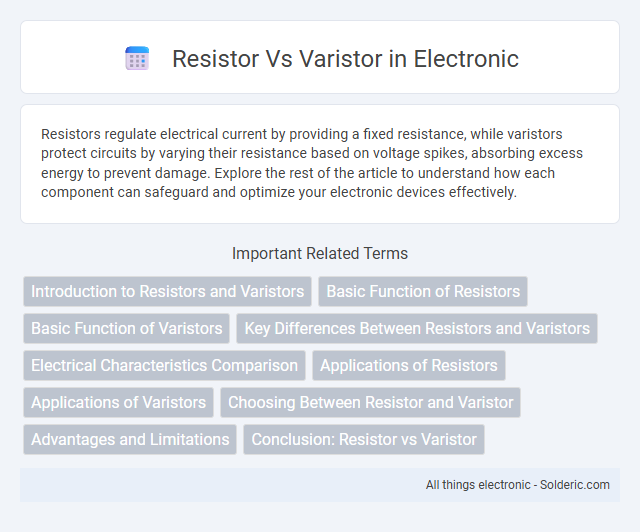Resistors regulate electrical current by providing a fixed resistance, while varistors protect circuits by varying their resistance based on voltage spikes, absorbing excess energy to prevent damage. Explore the rest of the article to understand how each component can safeguard and optimize your electronic devices effectively.
Comparison Table
| Feature | Resistor | Varistor |
|---|---|---|
| Function | Limits current by providing fixed resistance | Protects circuits by clamping voltage spikes |
| Component Type | Passive linear component | Non-linear voltage-dependent resistor |
| Operating Principle | Ohm's Law (V = IR) | Non-linear resistance changes with voltage |
| Applications | Current limiting, voltage division | Surge protection, transient voltage suppression |
| Voltage Handling | Fixed voltage drop based on resistance and current | Clamps voltage above a threshold (varies by model) |
| Response to Overvoltage | Cannot protect against voltage spikes | Absorbs and dissipates high-voltage surges |
| Power Rating | Specified in watts (W) | High surge current capacity |
| Common Materials | Carbon, metal film, wirewound | Metal oxide ceramics |
Introduction to Resistors and Varistors
Resistors regulate electrical current by providing a fixed resistance, ensuring stable voltage and current levels within circuits. Varistors protect devices from voltage spikes by changing resistance based on the applied voltage, absorbing transient surges to prevent damage. Both components serve crucial roles in circuit functionality, with resistors managing current flow and varistors safeguarding against voltage fluctuations.
Basic Function of Resistors
Resistors control the flow of electric current by providing a precise amount of resistance, which helps regulate voltage and protect circuits from damage. Unlike varistors that primarily protect against voltage spikes, resistors maintain stable current levels for proper functioning of electronic components. Your circuits rely on resistors to ensure consistent performance and prevent overheating.
Basic Function of Varistors
Varistors serve as voltage-dependent resistors that protect electronic circuits by clamping high voltage surges and preventing damage. Unlike fixed resistors, varistors dynamically change resistance based on the voltage applied, absorbing and dissipating transient energy. You rely on varistors to safeguard sensitive components from spikes caused by lightning or switching surges.
Key Differences Between Resistors and Varistors
Resistors regulate electrical current by providing a fixed resistance, ensuring consistent voltage and limiting current flow in circuits. Varistors, also known as voltage-dependent resistors, protect circuits by changing resistance with voltage fluctuations, absorbing transient surges and preventing damage. Understanding the key differences between resistors and varistors helps you choose the right component for circuit stability and protection.
Electrical Characteristics Comparison
Resistors exhibit a fixed resistance value that linearly limits current flow according to Ohm's law, maintaining stable voltage drops under normal operating conditions. Varistors, composed of metal oxide semiconductors, display nonlinear voltage-dependent resistance, rapidly decreasing resistance once a threshold voltage is exceeded to protect circuits from voltage surges. The primary electrical characteristic difference is that resistors provide predictable linear resistance, while varistors function as voltage-clamping devices with dynamic resistance tailored for transient voltage suppression.
Applications of Resistors
Resistors are widely used in electronic circuits for controlling current flow, dividing voltages, and protecting components from damage by limiting excessive current. You often find resistors in applications such as power supplies, signal processing circuits, and LED lighting systems to ensure stable and reliable operation. Unlike varistors, which primarily protect against voltage spikes, resistors provide consistent resistance values crucial for precise circuit functionality.
Applications of Varistors
Varistors are primarily used in electrical circuits for voltage clamping and surge protection, safeguarding sensitive components from voltage spikes caused by lightning strikes, power surges, or switching transients. Unlike resistors, which provide a constant resistance, varistors exhibit nonlinear resistance that rapidly changes with voltage, making them ideal for transient voltage suppression in power supplies, telecommunications equipment, and consumer electronics. Your devices benefit from varistors by maintaining stability and preventing damage during unexpected voltage fluctuations.
Choosing Between Resistor and Varistor
Choosing between a resistor and a varistor depends on the specific application requirements; resistors provide fixed resistance to control current flow, while varistors protect circuits by clamping voltage spikes with variable resistance. In power supply designs, resistors regulate current and voltage levels, whereas varistors safeguard against transient voltage surges caused by lightning or switching events. Selecting the appropriate component hinges on whether the goal is precise current control or transient voltage suppression in electrical and electronic circuits.
Advantages and Limitations
Resistors provide precise control of current and voltage with stable resistance values, making them ideal for circuit design and signal conditioning, but they lack protection against voltage surges. Varistors excel in protecting electronics by clamping high-voltage spikes and dissipating transient energy, enhancing circuit durability, yet they can degrade over time and offer limited precision in resistance. Choosing between resistors and varistors depends on whether the priority is stable resistance or transient voltage suppression.
Conclusion: Resistor vs Varistor
Resistors provide a constant resistance to control current flow and drop voltage in electrical circuits, ensuring predictable performance and stability. Varistors function as voltage-dependent resistors, protecting circuits by clamping excessive voltage spikes and preventing damage from transient surges. Choosing between a resistor and a varistor depends on the application's need for current regulation versus transient voltage suppression.
resistor vs varistor Infographic

 solderic.com
solderic.com